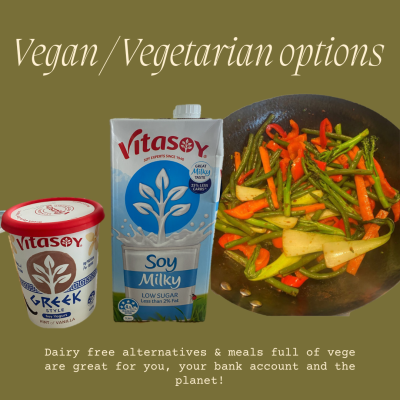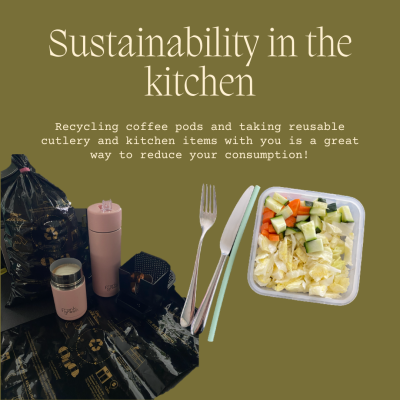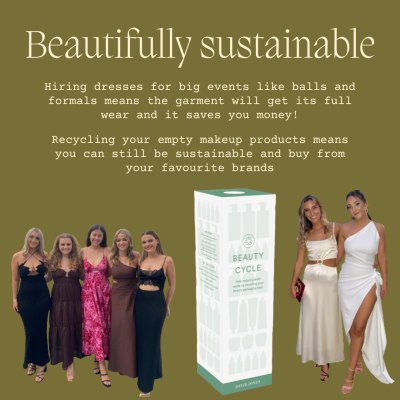
The Imperfect Environmentalist
The Imperfect Environmentalist
These days people associate sustainability with extremes. No one can seem to find the perfect balance of convenience and sustainability. Today, we will be looking to find the perfect balance to begin our journey as an imperfect environmentalist. If you came here looking to become a vegan wildlife warrior with zero waste in a matter of days, you’re probably in the wrong place. However, if you’re looking to make small changes to your lifestyle that incorporate sustainability then please stick around.
When I first began to consider my environmental impact, I thought it meant going completely vegan, only buying clothes from the op shop and being completely waste free. The thought of living like this horrified me – I love eating bacon and eggs for breakfast, keeping up with the latest fashion trends and the idea of being waste free was something I could never comprehend. But don’t fret! Being sustainable doesn’t have to be this extreme. Join me on this journey as I show you how you too can become an imperfect environmentalist.
As a university student living in a house with five other girls, we don’t always have the biggest budget or a lot of time on our hands, so these small changes have been created to suit our lifestyles. They’re not expensive or excessive – they’re perfectly imperfect.
Food
Food plays such an important role in our lives. We spend hours grocery shopping, cooking, and eating each week, so it was obvious to me that this was one of the easiest places to start making changes. When we first moved in, we noticed a lot of food waste and single use plastics from our cooking and grocery shopping. To alleviate this issue, I became more conscious about my grocery shopping. I must admit, the decision came after I read a cookbook that focused on using less dishes when cooking, buying vegetables in season and using leftovers in the cupboard. To start out, I began planning out my shopping. This was me carefully scowling the fridge, freezer, and cupboard for any food I could incorporate into my next meal. Then came the shopping lists. I promised myself I would never go to the grocery store again without a list, not only for my own sanity but to also prevent buying excess food. When shopping, I began to prioritise buying my fruit and veg from local produce stores – this meant I was decreasing the amount of greenhouse gas emissions used to transport produce to big supermarkets like Woolworths and Coles. I also began buying produce that was in season and would be used before it went off. Occasionally I didn’t have time to visit the local produce store, so to balance this out I made sure I didn’t buy any produce wrapped in plastic. When buying my produce, I always leave them loose in my basket, rather than using the plastic bags and when we’re done with the produce at home, we always try to grow our own veggies from the seeds and stems left over. And while I have promised you don’t have to be a crazy vegan to be sustainable, I always allocate one day a week where I eat vegan, or at least vegetarian for the day. Going dairy free is another great alternative if you can’t be meat free. My favourite vegan day would probably look a bit like soy yoghurt with berries and granola and a soy latte for breaky, tofu vermicelli noodle salad for lunch and a vegetable stir-fry for dinner! I often found that vego options are cheaper to make and taste even better than the meat… If you cannot bare to give up the meat, try a meat alternative! There are so many fake meat products on the market, and ones that even taste better than the real thing.

Kitchen
Although the kitchen goes hand in hand with the food were making and eating, I feel that the way we use our kitchen deserved a separate piece. As university students, we drink a lot of coffee! I am talking minimum two coffees a day each – which in our house equates to 10 aluminium coffee pods a day sent straight to landfill. In more recent times, we have begun recycling our coffee pods. When we order a new lot of pods online from Nespresso, we receive a recycling bag for our pods. They’re collected from a local store (ours is a two-minute drive) and sent back to the Nespresso facility where they recycle the residual coffee into compost and the aluminium pods are used to create new aluminium products. Another easy coffee related change is using a keep cup! Keep cups and reusable drink bottles can be found in almost every room of our house. We can’t get enough of them. Besides the fact that they’re great for the environment – they are so convenient. You can always carry cold water on you with an insulated water bottle and with a keep cup you’re able to drink your coffee on the way to work. When leaving the house, I also always take a cutlery set and reusable straws. Even if I don’t have time to make lunch for work, and I end up getting takeaway, bringing my own straws and cutlery is a very small and easy change that reduces my environmental impact. A mistake people make when using reusable cutlery is thinking they have to go out and buy a special set that collapse and are made of recyclable material. Me? I just take the cutlery we have in the draw at home. It is that simple.

Beauty Choices
Beauty is a big one for me. As a woman, I take a lot of pride in how I look and compromising on my appearance was not something I was ready to give up when I began my sustainability journey. It was important for me to realise that being sustainable doesn’t just mean buying sustainable products. It meant finishing makeup products completely before replacing them, recycling makeup containers and it also meant buying products with less packaging. A big sustainability issue for consumers isn’t buying products wrapped in plastic, it is actually over consumption and buying excess products. This meant I only bought makeup I absolutely needed. I stopped buying makeup for the sake of it and only considered buying a new product when mine had run out. I also started using testers before buying a new product. This meant I could try the product before I purchased it, incase it didn’t work for me and just ended up sitting at the bottom of my drawer. I also began recycling my empty makeup containers. David Jones recently introduced a system where you can drop off your containers, however a long-time favourite of mine has been the MAC program. For years you have been able to take back five empty products to MAC and receive a new lipstick for free. So you can see I definitely didn’t resort to mud-based makeup to be more sustainable. I also didn’t begin washing my hair with a bar of soap. Buying shampoo and conditioner in 1L sized refillable bottles was another small but productive step. Obviously, I could have bought bars of soap and makeup made of planet friendly products, but those products didn’t suit my needs. Some were too harsh on my dry skin, or even just too expensive. Although, speaking of expensive, by far my most expensive sustainable habit would be indulging in laser hair removal. While it obviously saves me so much time, it also dramatically reduces the amount of disposable plastic razors I use. But not everything has to be expensive, another great cost-effective beauty option for me is the choice to hire clothes. In the past I have been known to buy a dress for a special event and only wear it once. Hiring dresses solves this issue. It saves me hundreds of dollars, and it means the garment gets the most amount of wear possible. It isn’t collecting dust in a closet after one wear like it would be in my wardrobe.

All in all, I hope you’re able to visualise through my small lifestyle changes, that sustainability can be easy and inexpensive! Living more sustainably has actually saved me money, and made my life easier. There is nothing perfect about my sustainability habits, I use plastics, I drive my car to university sometimes, and I eat meat. But at the end of the day, I am conscious about reducing my footprint where I can. I hope this inspires you to think more about your daily habits and make small changes in your life where possible. You don’t have to be sustainable to be perfect and you don’t have to be perfect to be sustainable! The new age of sustainability is imperfect.
